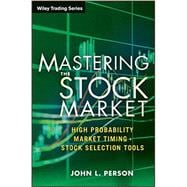
Note: Supplemental materials are not guaranteed with Rental or Used book purchases.
Purchase Benefits
Looking to rent a book? Rent Mastering the Stock Market High Probability Market Timing and Stock Selection Tools [ISBN: 9781118343487] for the semester, quarter, and short term or search our site for other textbooks by Person, John L.. Renting a textbook can save you up to 90% from the cost of buying.
JOHN L. PERSON is a thirty-two-year veteran of the trading industry, having worked as a floor trader, broker, analyst, and founder of NationalFutures.com, an online education site. He developed the Person Pivots (PPS) and other technical indicators that are on several companies' popular trading platforms, including TD Ameritrade, TradeStation, Open E Cry, NinjaTrader, Tradesignal, and Trade Navigator. Person has taught thousands of traders including members of the largest exchanges, and frequently speaks at industry conferences. He is the author of three nationally and internationally popular trading books as well as three trading courses and a DVD seminar series. Person's latest book, Commodity Trader's Almanac, is the authoritative guide to trading the seasonal aspects of the commodity markets and the correlated ETFs and stocks of those markets.
Introduction xi
Chapter 1: Stock Indexes and Sectors 1
Stock-Picking Quandary 4
Exchange-Traded Funds 6
The Options Market 14
Why Use Seasonal Analysis? 18
Chapter 2: Seasonal analysis 21
Pondering the Perks 25
Not All ETFs Are Measured Equally 30
Conclusion 58
Chapter 3: Sentiment analysis 59
The AAII Sentiment Survey 60
COT Data 61
Insider Trading Information 62
COT Data Components 63
Can Traders Benefi t and Make Money from This Information? 64
How Can This Information Possibly Be of Any Help to Us? 68
Compelling Evidence 75
Conclusion: COT Option Strategy 76
Chapter 4: Comparative relative Strength 79
What Is It Used For? 79
Creating the Charts 80
Spread Terminology 87
Automating Signals 95
Comparing Market Performance 99
Conclusion 102
Chapter 5: Breadth Studies 105
Trend-Line Analysis 107
Bearish Divergence Signals 114
Bullish Convergence Signals 119
Support and Resistance 121
Indicators and Moving Averages 125
Conclusion 135
Chapter 6: Volume Analysis 137
Hindsight Is 20/20 145
Current Event Analysis 148
Individual Stocks 149
Bearish Divergence 152
Bullish Convergence 154
Selling Climax 155
Exhaustion Tops 156
Trading Patterns 157
Volume and High-Frequency Traders 161
Volume Weighted Average Price 162
Chapter 7: Patterns, Indicators, and Oscillators 165
Candlesticks 166
The Doji 168
Reversal Patterns 169
Continuation Patterns 180
Conclusion: Indicator 101 201
Chapter 8: Scanning for Profits 203
Scanning the Universe 204
Trade Navigator 204
High- and Low-Close Doji Scans 206
Daily Scan Signals 208
Tradestation 212
Conclusion 227
Chapter 9: Pivot Point Analysis 233
Stock Trader’s Time Frame 238
Person’s Pivots Calculations 248
Fibonacci Combined with Pivot Points 262
Summary 263
Chapter 10: P utting It All Together 265
Position Sizing, Trade Entry Techniques, Risk Management,
Trailing Stops, and Trade Management
Calculating Position Size 267
Profit Targets 269
Stock Replacement Option Strategy 271
Day-Trading Position Sizing 271
Average True Range 272
Twice Baked 275
Order Entry Using PPS 276
Snap-Back Technique 276
Order Types 277
Stop Selection 279
The Exit 281
Expectations 282
Discipline 282
About the Author 285
Index 287
The New copy of this book will include any supplemental materials advertised. Please check the title of the book to determine if it should include any access cards, study guides, lab manuals, CDs, etc.
The Used, Rental and eBook copies of this book are not guaranteed to include any supplemental materials. Typically, only the book itself is included. This is true even if the title states it includes any access cards, study guides, lab manuals, CDs, etc.